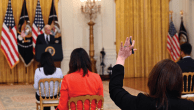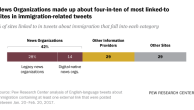Summary of Findings

As the nation marked the ninth anniversary of the Sept. 11 terror attacks last week, many in the public and the media focused more on current tensions over Islam in America – most notably plans by a Florida pastor to burn copies of the Koran.
Nearly two-in-ten (17%) say they followed the controversy over the pastor’s announcement that he would burn Korans on Sept. 11 more closely than any other major story. The burning did not happen, but the story ranked second on the list of stories followed most closely, according to the latest News Interest Index survey of 1001 adults by the Pew Research Center for the People & the Press. Another 9% say they followed news about the Sept. 11 anniversary most closely.
The media devoted 15% of the newshole last week to news dealing with anti-Muslim sentiments. Most of that (14%) focused on Pastor Terry Jones’ plans and the push to get him to cancel the Koran burning, according to the Pew Research Center’s Project for Excellence in Journalism (PEJ). An additional 4% of coverage focused on the continuing debate over a planned Muslim community center and mosque near the site of the World Trade Center towers in downtown Manhattan.
Despite the attention to religious controversies, Americans say they followed news about the major oil leak in the Gulf of Mexico – now stopped – more closely than other major news stories (27%). News about the spill, however, was limited (2% of the newshole). With coverage now focused on blame for the spill and its uncertain environmental impact, the public’s continued interest likely also reflects the story’s perceived importance.
A Mix of Good and Bad News About the Gulf Oil Spill
Following the April 20 oil rig explosion in the gulf that left 11 dead, interest in the story grew and stayed hig

h as the massive scale of the spill became clear and repeated efforts to stem the flow of oil failed. The story dominated the public’s interest for weeks.
By mid-July, BP was able to put a temporary cap in place. At that point, 48% said they were hearing a mix of good and bad news about the spill, 31% said they were hearing mostly bad news and 18% said they were hearing mostly good news.
Two months later, most Americans (58%) say they have been hearing a mix of good and bad news about the oil spill, up from 47% when the question was last asked Aug. 5-8. Fewer say they are hearing mostly bad news (19%) than in early August (25%), though the proportion hearing mostly good news is also down (from 25% to 17%).
Partisans Divide Over Media Coverage of Obama

More Americans (37%) say that press coverage of Barack Obama has been fair than say it has been too easy (27%) or too tough (23%). Those numbers are largely unchanged from July or April.
Not surprisingly, partisans have starkly different views on this question. About four-in-ten Democrats (41%) say coverage has been too tough, about the same as the 42% that said this in July, but up from 31% in April. Just 6% of Republicans say coverage of the Democratic president has been too tough.
Half of Republicans say coverage has been too easy, not much different from the 55% that said this in July or the 57% that did so in April. Just 12% of Democrats say press coverage of Obama has been too easy.
Independents largely mirror the general public. Four-in-ten say coverage of Obama has been fair, 28% say it has been too easy and 19% say it has been too tough.
Opinions about coverage of Democratic and Republican leaders in Congress also are little changed since mid-July. Currently, 40% say the press has been fair in coverage of GOP leaders, 24% say it has been too easy and 16% say it has been too tough.
Just more than four-in-ten (43%) say press coverage of Democratic leaders has been fair, 26% say too easy and 12% say too tough. Partisan views of coverage of party leaders are also little changed.
Nearly half of Republicans (47%) say coverage of Democratic leaders is too easy, 6% say too tough and 34% say fair. Most Democrats see coverage of Democratic leaders as fair (55%); 7% see it as too easy and 22% see it as too tough.
More than four-in-ten Democrats (44%) see coverage of Republican leaders in Congress as fair, 29% see it as too easy and 9% see it as too tough. Among Republicans, 35% see coverage as fair, a comparable 33% see it as too tough and 15% see it as too easy. Independents largely reflect the public as a whole.
The Week’s Other News
Americans paid close attention last week to three story lines with links to the events of Sept. 11, 2001. In addition to interest in the possible Koran burning (33% very closely), the public also very closely tracked news about developments in Afghanistan (30%) and Sept. 11 anniversary commemorations (33%).
One-in-ten say they followed news about the current situation and events in Afghanistan most closely last week, while news about the war there accounted for 3% of coverage, according to PEJ.
Nearly as many (9%) say they followed news about the ninth anniversary of the Sept. 11 attacks most closely. News about commemorations made up 2% of coverage. More than two-in-ten (22%) say they followed news about this year’s congressional elections very closely. This was the most closely followed news for 8% and accounted for 12% of coverage.
Some 16% say they followed the debate in Washington over competing Democratic and Republican tax plans very closely; 3% say this was the news they followed most closely. News about the tax plans made up 4% of coverage. In its overall analysis, PEJ included news about the tax debate with news about the economic crisis in general, a topic that accounted for 17% of coverage last week.

These findings are based on the most recent installment of the weekly News Interest Index, an ongoing project of the Pew Research Center for the People & the Press. The index, building on the Center’s longstanding research into public attentiveness to major news stories, examines news interest as it relates to the news media’s coverage. The weekly survey is conducted in conjunction with The Project for Excellence in Journalism’s News Coverage Index, which monitors the news reported by major newspaper, television, radio and online news outlets on an ongoing basis. In the most recent week, data relating to news coverage were collected September 6-12, and survey data measuring public interest in the top news stories of the week were collected September 9-12, from a nationally representative sample of 1,001 adults.
About the News Interest Index
The News Interest Index is a weekly survey conducted by the Pew Research Center for the People & the Press aimed at gauging the public’s interest in and reaction to major news events. This project has been undertaken in conjunction with the Project for Excellence in Journalism’s News Coverage Index, an ongoing content analysis of the news. The News Coverage Index catalogues the news from top news organizations across five major sectors of the media: newspapers, network television, cable television, radio and the internet. Each week (from Monday through Sunday) PEJ compiles this data to identify the top stories for the week. (For more information about the Project for Excellence in Journalism’s News Coverage Index, go to www.pewresearch.org/pewresearch-org/journalism.) The News Interest Index survey collects data from Thursday through Sunday to gauge public interest in the most covered stories of the week.
Results for this survey are based on telephone interviews conducted under the direction of Princeton Survey Research Associates International among a national sample of 1,001 adults living in the continental United States, 18 years of age or older, from September 9-12, 2010 (671 respondents were interviewed on a landline telephone, and 330 were interviewed on a cell phone, including 130 who had no landline telephone). Both the landline and cell phone samples were provided by Survey Sampling International. Interviews were conducted in English.
The combined landline and cell phone sample are weighted using an iterative technique that matches gender, age, education, race, Hispanic origin, region, and population density to parameters from the March 2009 Census Bureau’s Current Population Survey. The sample is also weighted to match current patterns of telephone status based on extrapolations from the 2009 National Health Interview Survey. The weighting procedure also accounts for the fact that respondents with both landline and cell phones have a greater probability of being included in the combined sample and adjusts for household size within the landline sample. Sampling errors and statistical tests of significance take into account the effect of weighting. The following table shows the error attributable to sampling that would be expected at the 95% level of confidence for different groups in the survey:

In addition to sampling error, one should bear in mind that question wording and practical difficulties in conducting surveys can introduce error or bias into the findings of opinion polls.




